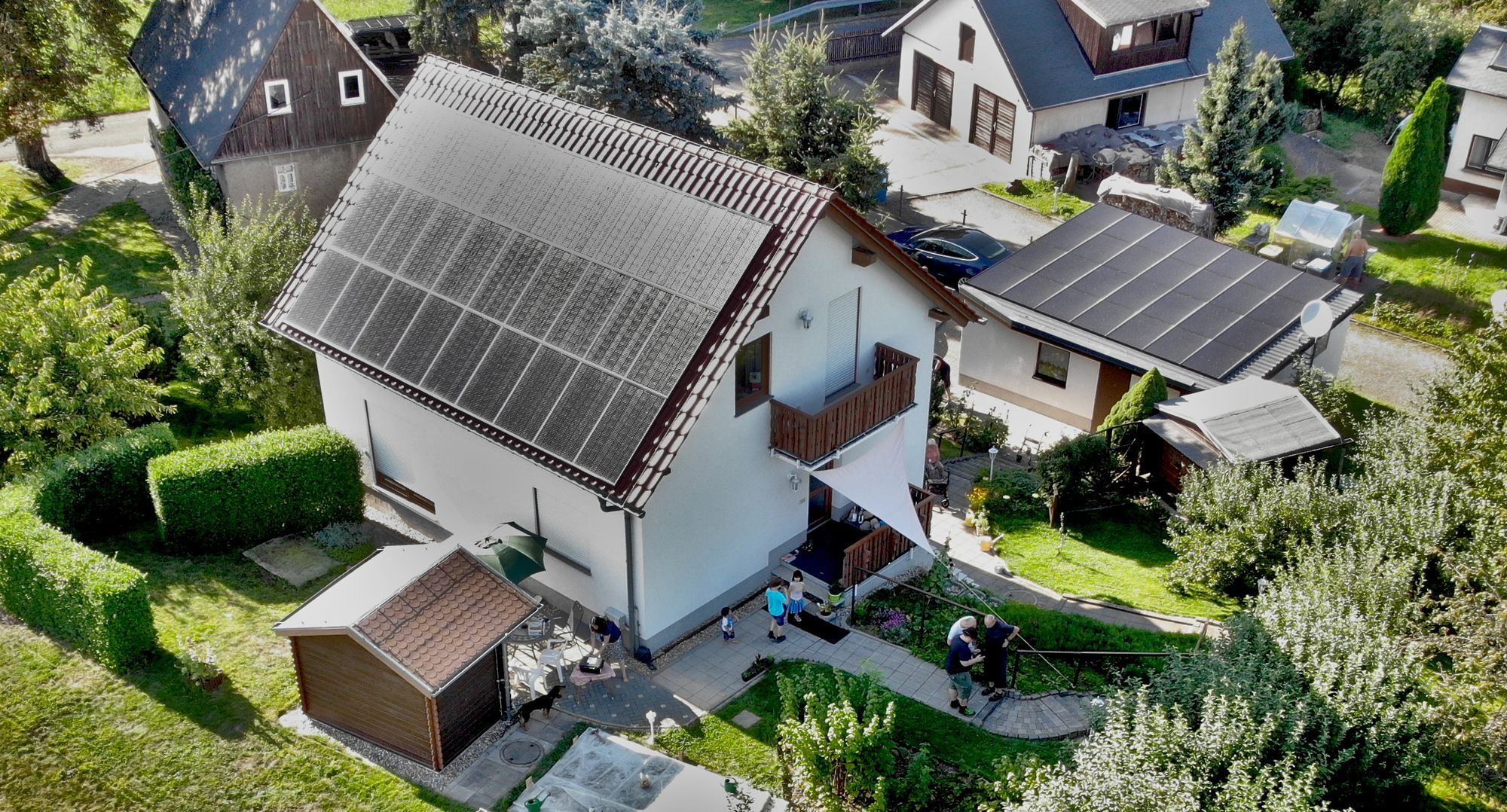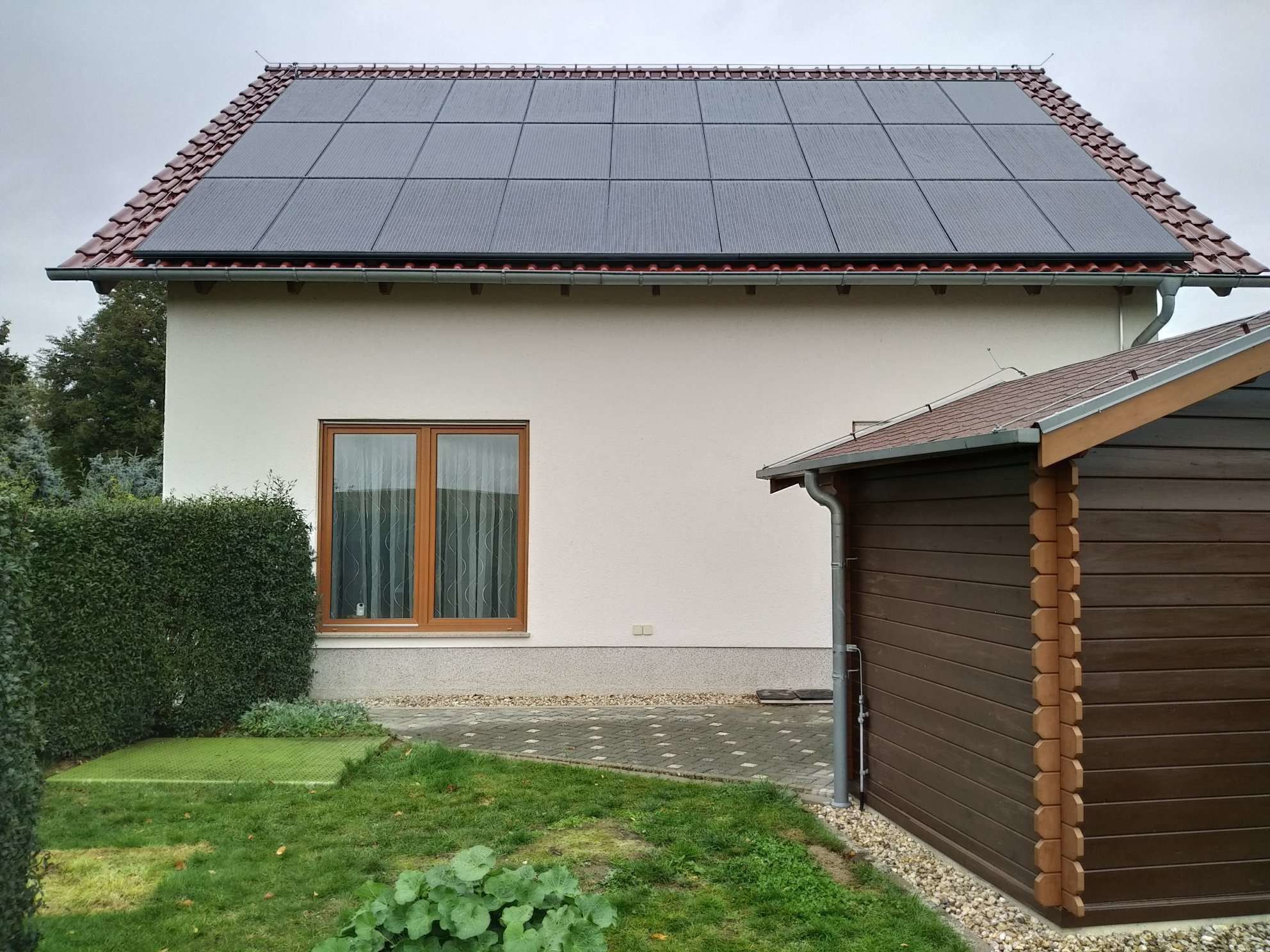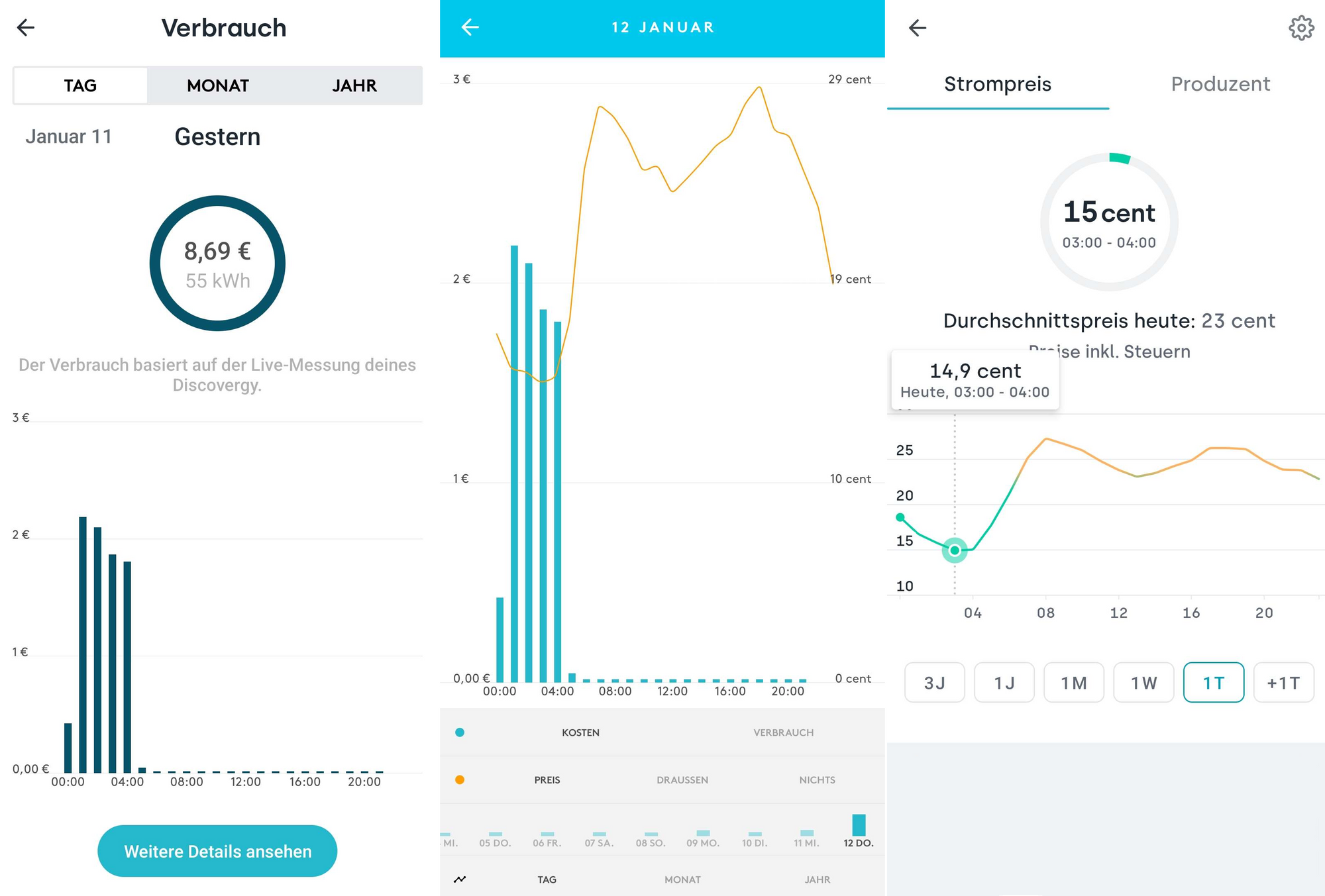Reference plant W1 Saxony
Protection and independence by the book.

| Plant in a nutshell | |
| Start of construction | 2019 |
| PV generators | 4 pieces (4550, 4550, 4875, 3900)Wp |
| PV capacity | 17875Wp (55 x 325Wp) |
| Storage capacity | 40kWh (2 x 20kWh) |
| Plant type | DC/AC hybrid, black start, 3-phase |
The investment decision of the customer, Mr. Steffen W., was not primarily driven by amortization, but by a desire for protection. If the property is to serve as a retirement residence in the future, it should protect the owners from the costs and imponderables of energy supply.
The system should therefore be durable, robust and, in particular, designed with self-sufficiency in mind. With these requirements, PetaJoule's core competence was exactly met.
Core

The core of the plant is a 3-phase system based on Victron Quattro inverters 3 x 5kVA in the "silent" version. These provide a so-called microgrid, which operates independently of the utility grid. The inverters draw on 2 x 20kWh LiFePO storage from PetaJoule and the system thus offers a potential bridging time of 2 days in the event that the Sun should break.
DC branch

The "DC branch" of the system is formed by two PV generators on the south roof (1 x 5s3p configuration with 4875Wp, 1 x 4s3p config. with 3900Wp), which bring their yield by means of two Victron MPPTs 250/85 into the storage or onto the DC bus. This subsystem is also responsible for the black start capability of the system. In case the battery would be empty, the energy utility company would not deliver anything and the diesel generator (more about this later) would not be available, the system can restart by itself when the sun shines. And yes, we even tested this once.
AC branch

The "AC branch" of the system is formed by a Fronius Symo 6kW inverter in the garage, which operates in the microgrid (i.e. again decoupled from the utility grid) and delivers the energy from two PV generators on the garage roof (4550Wp each) synchronously to all 3 phases in the house. Communication with the Venus GX controller is via in-house IP network. The Victrons regulate the power of the Fronius inverter by the grid frequency. However, this causes grid-synchronous clocks to run about 1% ahead in summer because the house grid frequency is raised when the battery is full.

When the sun is shining, the inverter has a cumulative power of 21kW (7kW per phase), with a possible short-term (30 seconds) overload of 12kW per phase. Without sunshine, or at night, this power is 5kW per phase (or 10kW short-term).
The maximum charging power of the system is 14.8 kW, which the 40kWh power storage unit can easily handle (corresponds to 0.37C - see remarks on battery practicability) and thus no negative consequences for its projected lifetime of 20-25 years are to be expected. The same applies accordingly to the nominal withdrawal power of 15kW (5kW per phase), but even a short-term load beyond that always remains below 1C.
Construction and extensions 2020-2022
In February 2020, the core of the system was installed (inverters, MPPTs, 20kWh battery) but no PV generators yet. Since the installation fell exactly in the time of the travel restrictions in the context of the Coronavirus crisis, this was of course a certain handicap.
In May 2020, the AC branch of the system was set up and could by itself cover the power consumption of the house until October 2020. Then, at the end of October 2020, the PV modules for the DC branch were installed and this was then able to cover the electricity demand in November.
In December, a small BEV (Seat Mii electric 32.3 KWh) was purchased, because it was apparent that the electricity surplus spring - fall also gives a free mobility. Installation of a wallbox also happened in this month.
In 2021, the system was in regular operation. The predicted and actual electricity surplus led to numerous optimizations in consumption. For example, the running times of the heat pump (separate power supply) were reduced and the temperatures in the storage tanks for hot water and heating were also raised.
The entire IT infrastructure (routers, switches, etc.) in the house was converted to DC power, as this allows communication and remote maintenance with the system even when the inverters are switched off and no AC is available.
In December 2021, a combustion engine was replaced with a Hyundai Kona electric 64 KWh. This vehicle will also be charged spring-autumn from the system's self-generated electricity.

In June 2022, the system received a second 20kWh battery, a DC subrail with another MPPT for an approximately 1kWp PV generator, and a Victron SmartShunt for accurate consumption metering in the DC system.
Balance 2022

The consumption - including electric vehicle(s) - in 2022 was approx. 11.5MWh, of which 9.8MWh could be covered by the plant. The plant does not feed into the power grid, but can draw from it as needed. Thanks to its own storage, this is done cost-effectively, taking advantage of low prices (e.g., at night), since Mr. W. has switched to an hourly exchange-based tariff:

The energy utility company purchases take place almost exclusively in December and January and, of course, include electricity for the BEVs.
Planned extensions
Since the inverters also allow the operation of classic power generators (gasoline or diesel generators), a small generator house is currently being built (as of early 2023), which will house an approx. 4.5kW diesel generator as well as fuel. On the roof of the generator house then additionally a small PV generator with 2s2p configuration (4 x 380Wp) will be built.
Opinion of the customer
This article may sound like an advertisement, but we simply think the system is well done and are proud to present it. However, let's let the customer have his say.
Steffen W. : "The advantages of the plant were clearly evident due to the advice and calculations of PetaJoule in advance and have also occurred exactly as predicted."
The economic advantages of the plant were not foreseeable at the time of planning and realization. Although the realization coincided with the Covid crisis, it was before the actual energy crisis or the price development on the market that occurred in this context. While an amortization of 20 years was expected, it currently looks more like 12 years.
Steffen W.: "I can only say that PetaJoule takes everything very carefully and the statements about the plant are very well-founded. From my practice the following advantages result:
✔️ no voltage interruption in the house, even for a short time
✔️ AC is consumed directly without conversion
✔️ DC goes into the storage
✔️ balancing of unbalanced load via DC bus
✔️ complete self-sufficiency
✔️ at mains "consumption current" variable is adjustable
✔️ in the transition period heating with heating rod
✔️ in summer and in the transition period hot water with heating rod
✔️ in winter use of favorable energy prices by exchange-dependent tariff (grid-serving)
Three-phase generator feed-in
✔️ Ramp for slow loading
✔️ Start/Stop automatic
Wallbox
✔️ 1 or 3 phase operation
✔️ in summer and in the transition period PV surplus charging
✔️ in winter usage of the low prices by exchange-dependent tariff
Reference plant
The plant can be visited by appointment.

